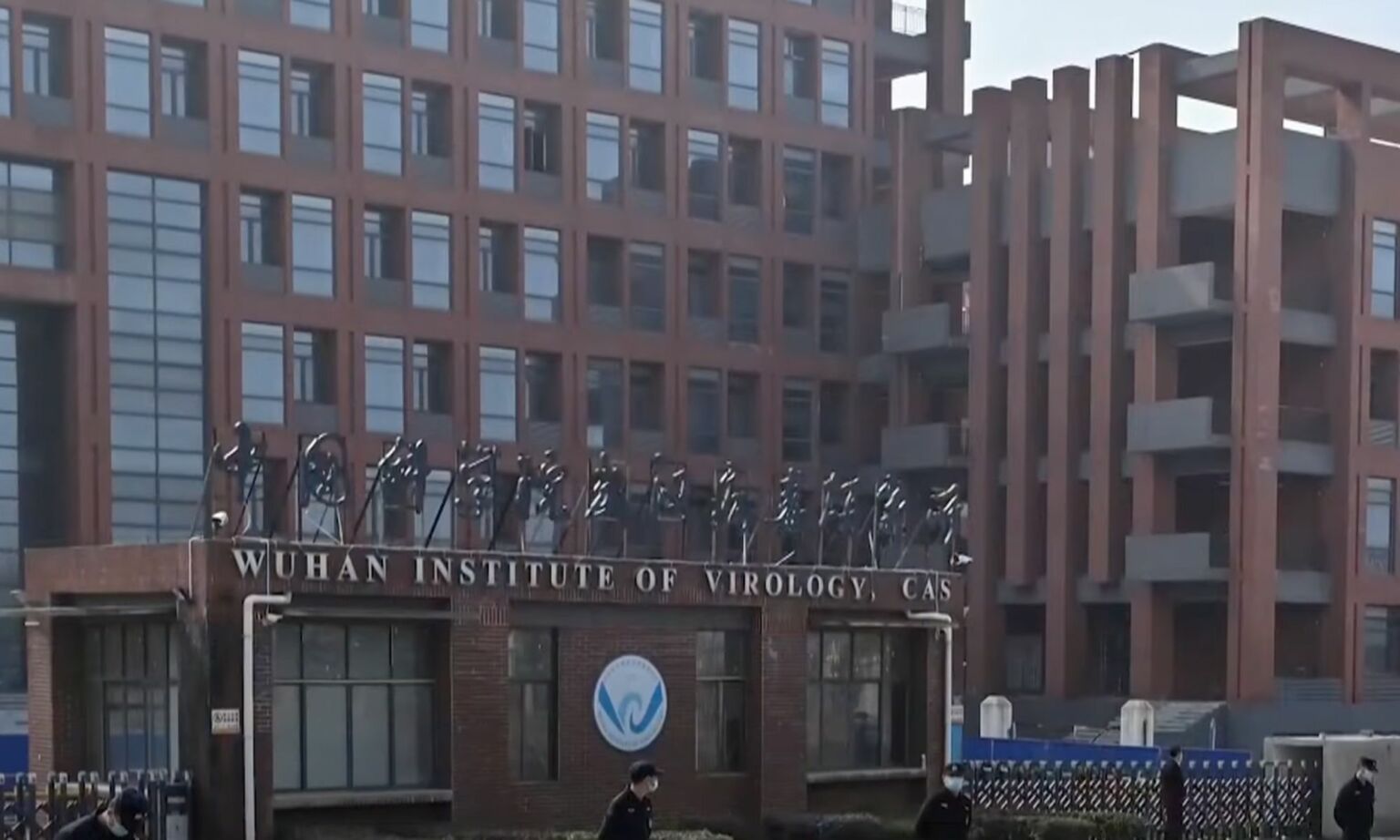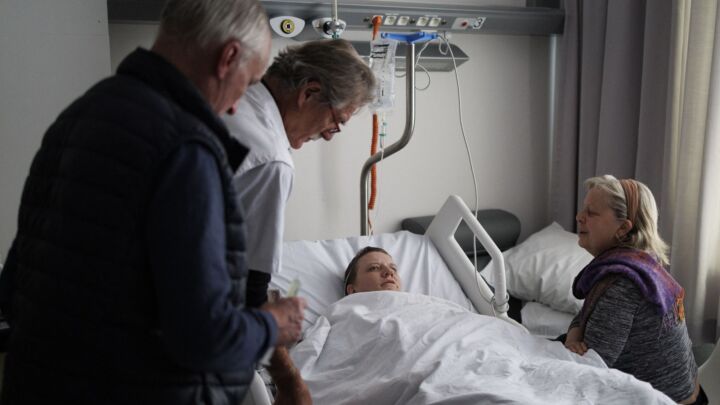
Long-read
The shameless cover-up of the lab-leak theory
The political and scientific establishment seems determined to suppress the truth about Covid’s origins.
Want to read spiked ad-free? Become a spiked supporter.
The more I think about it the more enraged it makes me. Back in late November, senior Tory minister Michael Gove was slapped down by the UK Covid inquiry’s head counsel, Hugo Keith, for raising the issue of where the virus originated. ‘There is a significant body of judgement that believes that the virus itself was man-made, and that presents challenges as well’, Gove said.
Gove was, I think, making the point that the question of Covid’s origins ought to matter to the inquiry. That’s because a laboratory-derived virus, being already trained on human cells, is bound to spread faster than one that has just jumped from an animal. And SARS‑CoV‑2 was unusually infectious for a pathogen new to the human species.
‘We’re not going to go there’, said Keith quickly, shutting Gove down. But why not go there?
Imagine, if you will, something similar happening in India after the Bhopal disaster in 1984, when thousands of people died after a cloud of toxic gas spread over the city following an accident at a pesticide factory. At the public inquiry set up to examine the response of the government to this disaster, ministers are grilled by a barrister about what they said to each other on that day, on why they did not stockpile enough medication, on why they were so slow to respond and so on. One of those ministers says, meekly: ‘There is a significant body of judgement that believes that the accident was not just an act of God but was caused by corporate negligence.’ ‘We’re not going to go there’, says the lawyer.
Imagine saying that the cause does not matter at an inquiry into how nearly a hundred people were crushed to death at Hillsborough football stadium in 1989; or how hundreds of people died when an airliner came down over Ukraine in 2014. It is completely normal to start inquiries into mass deaths by asking how they happened – so that you can stop them happening again, among other things.
British public inquiries have form for dodging the question of causes. In 1930, the world’s largest airship, the R101, crashed in France on its maiden voyage to India. The crash killed 48 of the 54 people on board, including the Labour government’s air minister, Lord Thomson. As SC Gwynne’s new book, His Majesty’s Airship, recounts, the subsequent inquiry outrageously came to the conclusion that the accident was nobody’s fault. This despite the abundant evidence that the airship was badly designed, hurriedly remodelled, inadequately tested and rushed into service so that Lord Thomson could ride the glory and be made viceroy of India.
Pandemics are not acts of God. Somebody somewhere did something that caused the virus to enter the human species. The evidence that this virus probably came from the Wuhan Institute of Virology is now voluminous, detailed and strong. That an outbreak caused by a bat sarbecovirus should happen in the one city in the world that had been collecting hundreds of bat sarbecoviruses and experimenting on them is striking enough. That it happened one year after that lab proposed inserting the one feature that distinguishes SARS‑CoV‑2 from all other viruses of the same kind makes it a heck of a coincidence. That the virus was highly infectious from the start, highly attuned to human receptors and evolving comparatively slowly, implying it had been already trained on human cells, was a shock. That the lab in question refuses to this day to release the database of the viruses it had been working on is as insulting as it is suspicious.

The coincidences of time and place are truly spectacular. The leading laboratory for bat sarbecoviruses in the world is not in Baltimore, Birmingham or Bombay. It is in Wuhan. When foot and mouth disease broke out near Pirbright in the UK in 2007, where the world’s leading reference laboratory for the foot-and-mouth virus is situated, it wasn’t a coincidence. When anthrax broke out downwind of a Soviet bioweapons factory in Sverdlovsk in 1979, it wasn’t a coincidence. When brucellosis broke out in Lanzhou in 2019, right by a brucellosis vaccine factory, it wasn’t a coincidence. And when smallpox infected a medical photographer at a smallpox lab in Birmingham in 1978, it wasn’t a coincidence. Lab leaks happen all the time. SARS itself leaked from labs after the end of the SARS epidemic of 2003 at least six times – once in Singapore, once in Taiwan and four times in Beijing.
Yet the vested interests in ignoring and dismissing the possibility of a Covid lab leak are legion. They include the Chinese authorities, the World Health Organisation (which obsequiously does President Xi Jinping’s bidding these days), and the American scientific establishment – especially Dr Anthony Fauci, the former head of the National Institute of Allergies and Infectious Diseases who funded some of the work at the Wuhan Institute of Virology. They also include EcoHealth Alliance, a New York non-profit headed up by Peter Daszak. EcoHealth Alliance has trousered millions of US taxpayer dollars since the SARS outbreak of 2003 for collecting viruses all over south-east Asia and sending them to the Wuhan Institute of Virology, all the while boasting of WIV’s gain-of-function experiments, which increase the infectivity of viruses.
And there are many others also invested in denying or dismissing the idea of a lab leak. There are some virologists who don’t want a light shone on their risky gain-of-function gravy train. And there is the academic world in general, which is terrified of doing anything to slow the flow of funds from China.
Indeed, we now know that the head of Harvard Medical School, George Daley, called Dr Fauci on 2 February 2020 to ask him to intervene to reassure a Chinese company, Evergrande, which was offering Harvard a donation of $115million. What could this Chinese property firm possibly need to hear from America’s top pandemic scientist? As investigative journalist Ashley Rindsberg reports, Daley wrote to Fauci saying: ‘I met yesterday with a team led by Jack Xia, CEO of China’s Evergrande company, and Dr Jack Liu, Evergrande’s chief health officer.’ They wanted ‘whatever information you are willing to share on your current efforts to coordinate a response [to Covid]’.
Evergrande went bust this year before delivering the cash, but the incentive it was offering to shut up about the possibility of a lab leak was probably obvious to all. And sure enough, two days after the call with Evergrande, Dr Fauci and his colleagues started shutting down speculation about a lab leak, even though they had open-mindedly discussed the possibility over the preceding weekend, with some scientists deeming it ‘friggin’ likely’. (Harvard Medical School declined to reply to Rindsberg’s requests for a comment.)
By contrast, there is almost nobody who has a vested interest in the origin of Covid being a lab leak. Even the media, which ought to see this as the story of the century, have mostly steered clear of it. That’s because unlike every other kind of journalist, science and health journalists for some reason generally see it as their duty to fawn over and echo but never challenge the establishment view. Where political, business, even arts reporters challenge and critique their subjects, science reporters almost never do. I should know: I used to be one and when I occasionally did question the establishment view, I was treated like a pariah.
A glimpse of the attitude of science journalists can be found in a now-deleted tweet from Apoorva Mandavilli, the science and global health reporter of the New York Times. In 2021, she wrote: ‘Someday we will stop talking about the lab-leak theory and maybe even admit its racist roots.’
Why exactly was it racist to consider a lab leak, but not racist to write long articles – as the New York Times did – about the ‘wet markets’ of China with their allegedly unsavoury habit of selling live, exotic animals in unhygienic conditions? We all remember those articles with their graphic speculations about bat soup and pangolin stew – even though there were no bats or pangolins on sale in Wuhan. One op-ed claimed that ‘China’s domestic demand and customs for exotic and live food are a direct threat to the health, safety and welfare of the world’. But it seems that ‘racism’ only applies to speculation about middle-class scientists, not about working-class market traders, who are not the sort of people New York Times reporters break bread with.
I tested the reluctance of the establishment to discuss the lab leak first hand. I asked the biological secretary of the UK’s Royal Society if she would organise a debate about the origin of the virus. No, she said, we only debate scientific matters. Eh? I asked the Academy of Medical Sciences, of which I am a fellow. Too controversial, they said. I asked a government minister. Better left to the World Health Organisation, he replied. I asked another government minister. Surely it’s time to move on, he said. I asked a very senior scientist. Better we never find out, he said, lest it annoy the Chinese. At least he was honest.

This leaves me in a bizarre situation. One of the commonest things people say to me these days is ‘you must be feeling vindicated’ because they know I co-wrote a book in 2022 arguing that the lab leak was a possibility, and most people now think it’s highly likely. Yet the establishment has yet to acknowledge this and the scientific journals still insist it’s a far-fetched conspiracy theory – even though they won’t dare to debate it. You would think that if they thought the public was wrong about this, they would want to get out there and persuade people.
There have been a handful of papers over the past few years claiming to show that a ‘natural’ zoonotic event in a market was a more likely cause. Sadly, these have generally proved to contain major errors. The one showing that cases were centred on the market missed out half the early cases. The one claiming to show that two separate animals infected people in the market miscalculated its probability statistics by two orders of magnitude. The one claiming an association of virus genetic material with raccoon-dog genetic material actually showed the opposite. The one claiming pangolins were involved is now accompanied by a long list of corrections. And so on. As George Gao, the former head of the Chinese Centre for Disease Control, has said again and again: this virus did not start in the market and no infected animal apart from human beings was found in the early days.
Millions are dead around the world and the most likely cause is an accident during a risky experiment in a laboratory. Should we not be learning lessons from that? Should we not share information globally on what virology experiments are being done, on which viruses, and at what biosafety levels? Should we not bring pressure to bear on those countries that refuse to share such information or that authorise such risky experiments? None of this is happening.
The World Health Organisation’s website is awash with calls for conferences and treaties on pandemic prevention. Yet the one issue that almost never gets mentioned is laboratory leaks. Search its website for the words ‘laboratory leak’ or ‘lab leak’ and just one single item comes up: the comical episode in 2021 when the WHO endorsed the ludicrous Chinese claim that Covid was more likely to have started with imported frozen food than with a lab leak.
There was no such reticence to discuss lab leaks before the Covid pandemic. Back in 2006, the WHO was keen to stress the risk of lab leaks of the first SARS virus: ‘A new epidemic of SARS would most likely emerge from an animal reservoir or a laboratory doing research with live cultures of SARS-CoV or handling stored clinical specimens containing SARS-CoV. The risk of re-emergence from a laboratory source is thought to be potentially greater.’
In 2012, scientist Lyn Klotz said that ‘there is a substantial probability that a pandemic with over 100million fatalities could be seeded from an undetected lab-acquired infection, if a single infected lab worker spreads infection as he moves about in the community’.
And in 2017, Peter Daszak, the $460,000-a-year head of the EcoHealth Alliance, was happy to talk about the world facing an increasing risk from the accidental release of ‘laboratory-enhanced variants’. In a slide shown as part of a pitch for funding, he said that ‘gain-of-function and “DIY” research is elevating the risk of the accidental and / or deliberate release of deadly novel biological agents’. (Although six months earlier he had written in an email stating ‘we are very happy to hear that our gain-of-function research funding pause has been lifted’.)
There are no doubt other reasons why Daszak in particular does not want a debate about the risks of lab leaks. News emerged this week involving Daszak that strengthens the case for a lab leak having happened in Wuhan. It shocks even hardened cynics like myself.
We have known for two years that Dazsak was the author of the ‘DEFUSE’ proposal to the Pentagon’s Defense Advanced Research Projects Agency (DARPA) in 2018, asking for $14million for research on bat sarbecoviruses. It was shocking enough that he failed to tell the world about this proposal, which was leaked instead. It was still more shocking to find that it contained a specific proposal for inserting ‘human-specific cleavage sites’ into sarbecoviruses for the first time, because exactly such a feature is found in the virus that causes Covid, and in none of the other 1,500 known sarbecoviruses. That cleavage site is the reason we had a pandemic because it makes the virus more infectious in human airways and it seems uniquely suited to the human system. Since that document leaked, Daszak has always defended himself by saying that his funding request was turned down, and that he had proposed to do that experiment at Ralph Baric’s lab in North Carolina, not in Shi Zhengli’s lab in Wuhan.
Then this week, Emily Kopp, from an organisation called US Right to Know, received another leak. This was an earlier version of Daszak’s proposal, on which Daszak and Baric had typed marginal comments. Incredibly, these show that Daszak intended to deceive DARPA and do more of the work in Wuhan: ‘If we win this contract, I do not propose that all of this work will necessarily be conducted by Ralph [Baric], but I do want to stress the US side of this proposal so that DARPA are comfortable with our team. Once we get the funds, we can then allocate who does what exact work, and I believe that a lot of these assays can be done in Wuhan as well.’
Baric then replied that this meant the work would be done at lower biosafety levels, BSL2 instead of BSL3: ‘In the US, these recombinant SARS-CoV are studied under BSL3… In China, [we] might be growin[g] these virus[es] under BSL2. US [researchers] will likely freak out.’ As for whether this was funded – well, there is every chance the work went ahead with funding from the Chinese Academy of Sciences.
Daszak and colleagues planned to harvest wild bat viruses of exactly the same kind that later caused Covid, soup them up in the lab, infect human cells with them and do so at low biosafety levels that would ‘freak out’ other Western researchers. They planned to do all this in a city called Wuhan. And since then, they have chosen not to tell the world that this is what they had proposed.
The coincidences continue to mount. So in sum, a global pandemic began in 2019 very close to a lab that was doing risky, gain-of-function research on the very same kind of virus as Covid. Since then, the scientific and public-health establishment has tried to shut down debate on the origins of the virus and has refused to talk about the risk of lab leaks. The silence speaks volumes.
Matt Ridley is co-author of Viral: The Search for the Origin of Covid-19, with Alina Chan.
Picture by: Getty.
Who funds spiked? You do
We are funded by you. And in this era of cancel culture and advertiser boycotts, we rely on your donations more than ever. Seventy per cent of our revenue comes from our readers’ donations – the vast majority giving just £5 per month. If you make a regular donation – of £5 a month or £50 a year – you can become a and enjoy:
–Ad-free reading
–Exclusive events
–Access to our comments section
It’s the best way to keep spiked going – and growing. Thank you!






Comments
Want to join the conversation?
Only spiked supporters and patrons, who donate regularly to us, can comment on our articles.